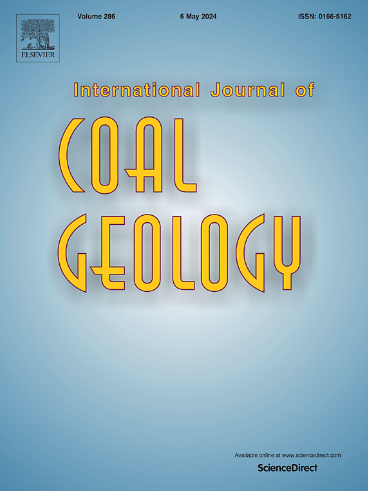哥伦比亚安第斯山脉东科迪勒拉盆地白垩纪-古近纪过渡时期煤炭沉积的古环境重建
IF 5.6
2区 工程技术
Q2 ENERGY & FUELS
引用次数: 0
摘要
沿海和大陆环境下的泥炭层堆积模式和影响因素是研究含煤层序的一个重要问题。为解决这一问题,本研究重点研究了哥伦比亚安第斯山脉东科迪勒拉盆地 Checua-Lenguazaque Syncline(CLS)煤田的白垩纪-古近纪 Guaduas 地层。这项研究依赖于地质调查、岩相分析、层序地层学、有机地球化学和煤岩相学。通过这些方法,确定了沉积系统和层序的特征,以及它们与煤炭成分的关系。沉积面被划分为四个面系(FAs):泻湖、潮汐平地、三角洲平原和混合河道系统。确定了五个 T-R 序列(S1 至 S5,按升序排列)。S1 由泻湖和潮汐砂岩、泥岩和煤组成。S2 至 S4 由潮汐沉积、三角洲沉积和河流沉积组成。S5 主要由三角洲和河流地层组成。厚煤层(> 0.7 米)集中在 S1 和 S3 的回归系地层中,而横向煤炭则沉积在 S2-S3 中,与潮汐环境有关。有机岩相显示富含玻璃石(30.00-85.20%),而锂辉石(0.00-16.60%)和惰性石(4.60-34.40%)则因深度和古环境而异。CLS 煤田显示了从浅海和泻湖沉积到三角洲和河流环境的环境演变。轻微的海平面波动、容纳性的变化、硅质岩的涌入以及植物群落都是这一沉积演替的特征。瓜杜阿斯地层的沉积特点是在高容积环境中以浅上循环为主的渐进模式。有机质是在中营养到外营养环境中的石灰质到石灰质条件下积累的,营养物质主要来自降雨。瓜杜阿斯地层的古气候表明,潮湿和炎热的条件有利于植物群的扩展。这项调查确定了热带纬度地区马斯特里赫特-古新世沿海到河道演替的古环境,表明沉积系统、层序地层学、古气候和煤炭成分之间有着密切的关系。本文章由计算机程序翻译,如有差异,请以英文原文为准。
Paleoenvironmental reconstruction of coal deposition during the Cretaceous-Paleogene transition in the Eastern Cordillera Basin, Colombian Andes
Stratal stacking patterns and factors influencing peat accumulation in coastal and continental settings represent a significant problem in studying coal-bearing sequences. To address this issue, this work focused on the Cretaceous-Paleogene Guaduas Formation on the Checua-Lenguazaque Syncline (CLS) coalfield in the Eastern Cordillera Basin (Colombian Andes). This study relies on geological survey, facies analysis, sequence stratigraphy, organic geochemistry, and coal petrography. Through these methods, depositional systems and sequences were characterized, and their relationship with coal composition was established. Sedimentary facies were categorized into four Facies Associations (FAs): lagoon, tidal flat, delta plain, and mixed fluvial system. Five T-R sequences (S1 to S5, in ascending order) were identified. S1 consists of lagoon and tidal sandstone, mudstone, and coal. S2-S4 comprise tidal, deltaic, and fluvial deposits. S5 is composed mainly of deltaic and fluvial facies. Thick coal seams (> 0.7 m) were concentrated in the regressive system tracts of S1 and S3, while the transgressive coals were deposited in S2-S3 and are associated with tidal environments. The organic petrography showed enrichment in vitrinite (30.00–85.20 %), while liptinite (0.00–16.60 %) and inertinite (4.60–34.40 %) varied according to depth and paleoenvironments. CLS coalfield displays an environmental evolution from shallow marine and lagoon deposits to deltaic and fluvial environments. Minor sea-level fluctuations, changes in accommodation, siliciclastic influx, and plant community distinguish this sedimentary succession. The deposition of the Guaduas Formation is characterized by a prograding pattern with dominant shallowing-upward cycles in a high accommodation setting. The organic matter accumulated under limno-telmatic to telmatic conditions in mesotrophic to ombrotrophic environments with nutrients derived mainly from rainfall. The paleoclimate for the Guaduas Formation indicates wet and hot conditions for flora expansion. This investigation determined paleoenvironments of the Maastrichtian-Paleocene coastal to fluvial successions within the tropical latitudes, indicating a strong relationship between depositional systems, sequence stratigraphy, paleoclimate, and coal composition.
求助全文
通过发布文献求助,成功后即可免费获取论文全文。
去求助
来源期刊

International Journal of Coal Geology
工程技术-地球科学综合
CiteScore
11.00
自引率
14.30%
发文量
145
审稿时长
38 days
期刊介绍:
The International Journal of Coal Geology deals with fundamental and applied aspects of the geology and petrology of coal, oil/gas source rocks and shale gas resources. The journal aims to advance the exploration, exploitation and utilization of these resources, and to stimulate environmental awareness as well as advancement of engineering for effective resource management.
 求助内容:
求助内容: 应助结果提醒方式:
应助结果提醒方式:


